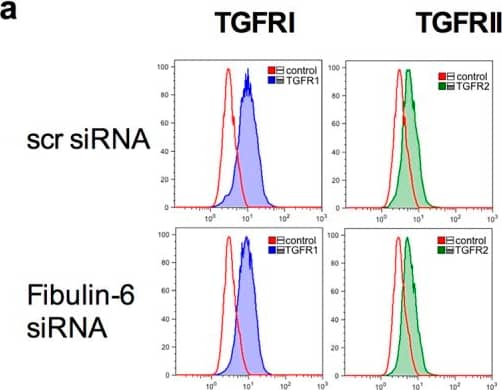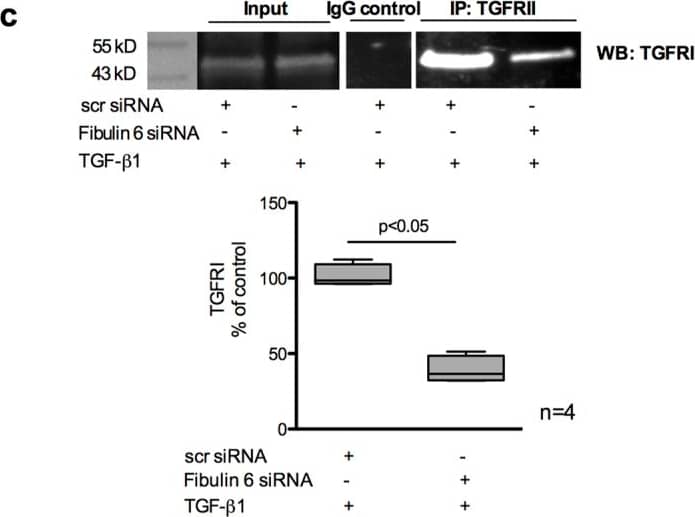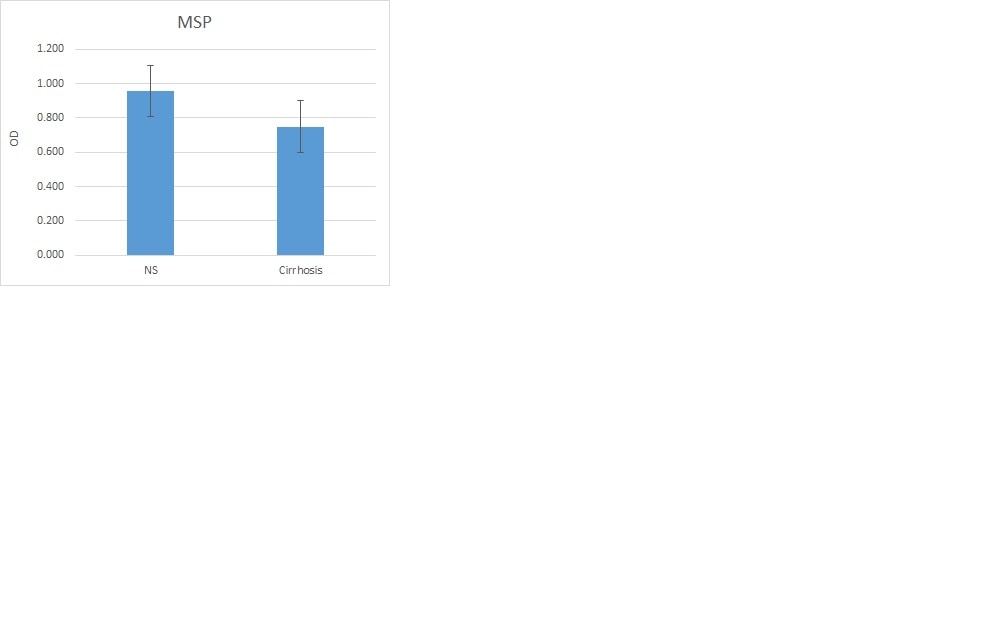Human MSP/MST1 Antibody Summary
Gln19-Gly711
Accession # AAA59872
Applications
Please Note: Optimal dilutions should be determined by each laboratory for each application. General Protocols are available in the Technical Information section on our website.
Scientific Data
 View Larger
View Larger
Chemotaxis Induced by MSP and Neutralization by Human MSP Antibody. Recombinant Human MSP (Catalog # 352-MS) chemoattracts mouse peritoneal resident macrophages in a dose-dependent manner (orange line). The amount of cells that migrated through the filter was measured by LeukoStat™ staining (Fisher Scientific). Chemotaxis elicited by Recombinant Human MSP (50 ng/mL) is neutralized (green line) by increasing concentrations of Goat Anti-Human MSP Antigen Affinity-purified Polyclonal Antibody (Catalog # AF352). The ND50 is typically 0.05-0.2 µg/mL.
 View Larger
View Larger
Detection of Mouse MSP/MST1 by Flow Cytometry TGFRI and TGFRII association in fibulin-6 KD cells upon TGF-beta stimulus.scr siRNA or fibulin-6 siRNA transfected nCF, after TGF-beta stimulation are subjected to (a) FACS analysis. No difference in the amount of TGF beta RI and TGF beta RII on the surface of control and fibulin-6 KD cells was observed. (b) Immuno-precipitation of TGFRII from cell lysates of scr transfected and TGF-beta stimulated cells, shows more accumulation of TGFRI after western blotting compared to non TGF-beta treated nCF. (c) Immuno-precipitation of TGFRII followed by WB for TGFRI from cell lysates of scr transfected or fibulin-6 KD cells after TGF-beta stimulation display reduced association of receptors in fibulin-6 KD condition. The control input lanes shows no difference and IgG control is also clean (n = 4, p < 0.05). (d) Phosphorylation status of TGFRI was analyzed by western blot using phospho-TGFRI specific antibody. Densitometric analysis of western blot display decreased phosphorylation of TGFRI in fibulin-6 KD cells after TGF-beta stimulation compared to control cells (n = 5, p < 0.01, nonparametric Mann-Whitney U test). Image collected and cropped by CiteAb from the following open publication (https://pubmed.ncbi.nlm.nih.gov/28209981), licensed under a CC-BY license. Not internally tested by R&D Systems.
 View Larger
View Larger
Detection of Mouse MSP/MST1 by Immunoprecipitation TGFRI and TGFRII association in fibulin-6 KD cells upon TGF-beta stimulus.scr siRNA or fibulin-6 siRNA transfected nCF, after TGF-beta stimulation are subjected to (a) FACS analysis. No difference in the amount of TGF beta RI and TGF beta RII on the surface of control and fibulin-6 KD cells was observed. (b) Immuno-precipitation of TGFRII from cell lysates of scr transfected and TGF-beta stimulated cells, shows more accumulation of TGFRI after western blotting compared to non TGF-beta treated nCF. (c) Immuno-precipitation of TGFRII followed by WB for TGFRI from cell lysates of scr transfected or fibulin-6 KD cells after TGF-beta stimulation display reduced association of receptors in fibulin-6 KD condition. The control input lanes shows no difference and IgG control is also clean (n = 4, p < 0.05). (d) Phosphorylation status of TGFRI was analyzed by western blot using phospho-TGFRI specific antibody. Densitometric analysis of western blot display decreased phosphorylation of TGFRI in fibulin-6 KD cells after TGF-beta stimulation compared to control cells (n = 5, p < 0.01, nonparametric Mann-Whitney U test). Image collected and cropped by CiteAb from the following open publication (https://pubmed.ncbi.nlm.nih.gov/28209981), licensed under a CC-BY license. Not internally tested by R&D Systems.
 View Larger
View Larger
Detection of Mouse MSP/MST1 by Immunoprecipitation TGFRI and TGFRII association in fibulin-6 KD cells upon TGF-beta stimulus.scr siRNA or fibulin-6 siRNA transfected nCF, after TGF-beta stimulation are subjected to (a) FACS analysis. No difference in the amount of TGF beta RI and TGF beta RII on the surface of control and fibulin-6 KD cells was observed. (b) Immuno-precipitation of TGFRII from cell lysates of scr transfected and TGF-beta stimulated cells, shows more accumulation of TGFRI after western blotting compared to non TGF-beta treated nCF. (c) Immuno-precipitation of TGFRII followed by WB for TGFRI from cell lysates of scr transfected or fibulin-6 KD cells after TGF-beta stimulation display reduced association of receptors in fibulin-6 KD condition. The control input lanes shows no difference and IgG control is also clean (n = 4, p < 0.05). (d) Phosphorylation status of TGFRI was analyzed by western blot using phospho-TGFRI specific antibody. Densitometric analysis of western blot display decreased phosphorylation of TGFRI in fibulin-6 KD cells after TGF-beta stimulation compared to control cells (n = 5, p < 0.01, nonparametric Mann-Whitney U test). Image collected and cropped by CiteAb from the following open publication (https://pubmed.ncbi.nlm.nih.gov/28209981), licensed under a CC-BY license. Not internally tested by R&D Systems.
Reconstitution Calculator
Preparation and Storage
- 12 months from date of receipt, -20 to -70 °C as supplied.
- 1 month, 2 to 8 °C under sterile conditions after reconstitution.
- 6 months, -20 to -70 °C under sterile conditions after reconstitution.
Background: MSP/MST1
Macrophage stimulating protein (MSP), also known as HGF-like protein, and scatter factor-2, is a member of the HGF family of growth factors (1). MSP is secreted as an inactive single chain precursor (pro-MSP) that contains a PAN/APPLE-like domain, four kringle domains, and a peptidase S1 domain which lacks enzymatic activity (2). Human MSP shares 79% aa sequence identity with mouse MSP and 44% aa sequence identity with human HGF. Pro-MSP is secreted by hepatocytes under the positive and negative control of CBP in complex with either HNF-4 or RAR, respectively (3). Circulating pro-MSP is proteolytically cleaved in response to tissue injury to yield biologically active disulfide linked heterodimers consisting of a 45‑62 kDa alpha and a 25‑35 kDa beta chain (4, 5). Pro-MSP can be activated by MT-SP1, a transmembrane protease that is expressed on macrophages and is upregulated in many cancers (6). Heterodimeric MSP as well as the isolated beta chain bind to MSP R/Ron with high-affinity, although only heterodimeric MSP can induce receptor dimerization and signaling (7, 8). MSP induces macrophage and keratinocyte proliferation and osteoclast activation (9, 10). It also inhibits LPS- or IFN-induced iNOS and IL-12 expression by macrophages and prevents apoptosis of epithelial cells separated from the ECM (11, 12).
- Wang, M.-H. et al. (2002) Scand. J. Immunol. 56:545.
- Han, S. et al. (1991) Biochemistry 30:9768.
- Muraoka, R.S. et al. (1999) Endocrinology 140:187.
- Wang, M.-H. et al. (1996) J. Clin. Invest. 97:720.
- Nanney, L.B. et al. (1998) J. Invest. Dermatol. 111:573.
- Bhatt, A.S. et al. (2007) Proc. Natl. Acad. Sci. 104:5771.
- Wang, M.-H. et al. (1997) J. Biol. Chem. 272:16999.
- Danilkovitch, A. et al. (1999) J. Biol. Chem. 274:29937.
- Wang, M.-H. et al. (1996) Exp. Cell Res. 226:39.
- Kurihara, N. et al. (1998) Exp. Hematol. 26:1080.
- Morrison, A.C. et al. (2004) J. Immunol. 172:1825.
- Liu, Q.P. et al. (1999) J. Immunol. 163:6606.
Product Datasheets
Citations for Human MSP/MST1 Antibody
R&D Systems personnel manually curate a database that contains references using R&D Systems products. The data collected includes not only links to publications in PubMed, but also provides information about sample types, species, and experimental conditions.
3
Citations: Showing 1 - 3
Filter your results:
Filter by:
-
Comprehensive analysis of receptor tyrosine kinase activation in human melanomas reveals autocrine signaling through IGF-1R
Authors: Kerrington R. Molhoek, Amber L. Shada, Mark Smolkin, Sudhir Chowbina, Jason Papin, David L. Brautigan et al.
Melanoma Research
-
Fibulin-6 regulates pro-fibrotic TGF-beta responses in neonatal mouse ventricular cardiac fibroblasts.
Authors: Chowdhury A, Hasselbach L, Echtermeyer F, Jyotsana N, Theilmeier G, Herzog C
Sci Rep, 2017-02-17;7(0):42725.
Species: Mouse
Sample Types: Cell Lysates, Whole Cells
Applications: Co-Immunoprecipitation, Flow Cytometry -
Macrophage-stimulating protein is produced by tubular cells and activates mesangial cells.
Authors: Rampino T, Collesi C, Gregorini M
J. Am. Soc. Nephrol., 2002-03-01;13(3):649-57.
Species: Human
Sample Types: Cell Lysates, Whole Cells, Whole Tissue
Applications: IHC-P, Neutralization, Western Blot
FAQs
No product specific FAQs exist for this product, however you may
View all Antibody FAQsReviews for Human MSP/MST1 Antibody
Average Rating: 4 (Based on 1 Review)
Have you used Human MSP/MST1 Antibody?
Submit a review and receive an Amazon gift card.
$25/€18/£15/$25CAN/¥75 Yuan/¥2500 Yen for a review with an image
$10/€7/£6/$10 CAD/¥70 Yuan/¥1110 Yen for a review without an image
Filter by:
We used this antibody for developing a sandwich ELISA in combination with mAb (MAB352) and protein (352-MS). This combination worked well and detected human MSP in serum samples efficiently.


